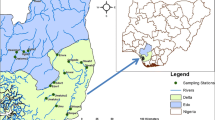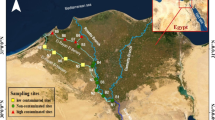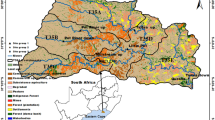Abstract
In the past three decades, macroinvertebrate traits have been explored and employed in the biomonitoring of riverine systems globally, but much attention has not been given to the trait-based approach (TBA) in Nigeria. Therefore, in this study, the distribution patterns of macroinvertebrate traits in selected stations exposed to varying degrees of perturbation in River Hadejia, north-western Nigeria, were explored to assess the ecological health of the river. Three stations were selected, representing an increasing gradient of pollution: station 1 > station 2 and station 3, and were used to search for potential indicator traits. Four traits, including body size, respiratory, mobility, and body shape, were selected and classified into 12 trait attributes. The RLQ analysis revealed macroinvertebrates possessing medium and large body sizes, climbing and crawling, tegumental, gills, and aerial: lungs respiratory traits, and streamlined body shape were associated with station 1. Conversely, macroinvertebrates possessing very small and small body sizes, aerial: spiracle and aerial/vegetation, sprawling, swimming, and skating, flattened, spherical, cylindrical, and rhomboidal were mainly associated with stations 2 and 3. In searching for potential indicator macroinvertebrate traits aside from the RLQ analysis conducted, a fourth-corner analysis was further performed, which showed traits including medium and large body sizes, tegumental, and aerial: lung respiratory traits to be sensitive to pollution. Equally, aerial/vegetation, flattened body shape, and very small body size were found to be tolerant of pollution. A more robust trait-based biomonitoring study using more trait classes such as feeding mechanism, food preferences, voltinism, and attachment mechanism is recommended for future study in this region. The study would be helpful in biomonitoring of ecosystem health and enhance the sustainability prowess of the TBA in the studied region.







Similar content being viewed by others
Data availability
Datasets used in the present study will be made available by the corresponding author upon request without any hesitation.
References
Adam, M. B., Edegbene, A. O., & Jibrin, G. (2020). Monitoring and exploring the spatio-temporal variation of physico-chemical variables of River Hadejia, Nigeria; using statistical approach. Asian Journal of Geographical Research, 3(1), 49–61. https://doi.org/10.9734/AJGR/2020/v3i130100
Akamagwuna, F. C., Ntloko. P. A., Edegbene, O., & Odume, O. N. (2021). Are ephemeroptera, plecoptera and trichoptera traits reliable indicators of semi urban pollution in the Tsitsa River, Eastern Cape Province of South Africa ? Environmental Monitoring and Assessment, 1–15. https://doi.org/10.1007/s10661-021-09093-z
Akamagwuna, F.C., Mensah, P.K., Nnadozie, C.F. & Odume, O.N. (2019). Traits-based responses of ephemeroptera, plecoptera and trichoptera to sediment stress in the Tsitsa River and its tributaries, Eastern Cape, South Africa. River Research and Applications. https://doi.org/10.1002/rra.3458.
APHA (American Public Heath Association). (1998). Standard methods for the examination of water and wastewater, WEF and AWWA, 20th Edition, USA. 1213Pp.
Arimoro, F. O., Odume, O. N., Uhunoma, S. I., & Edegbene, A. O. (2015). Anthropogenic impact on water chemistry and benthic macroinvertebrate associated changes in a southern Nigeria stream. Environmental Monitoring and Assessment, 187(2), 1–14.
Benfield, E. F., Dolloff, C. A., Fell, R. D., & Salom, S. M. (2006). Ecological studies of benthic macroinvertebrates for determining sedimentation impacts in Chattahoochee National Forest streams. Thesis. https://doi.org/10.1073/pnas.0703993104
Bilotta, G. S., & Brazier, R. E. (2008). Understanding the influence of suspended solids on water quality and aquatic biota. Water Research, 42, 2849–2861.
Bonada, N., Rieradevall, M., & Prat, N. (2007). Macroinvertebrate community structure and biological traits related to flow permanence in a Mediterranean river network. Hydrobiologia, 589(1), 91–106. https://doi.org/10.1007/s10750-007-0723-5
Castro, D. M. P., Dolédec, S., & Callisto, M. (2018). Land cover disturbance homogenizes aquatic insect functional structure in neotropical savanna streams. Ecological Indicators, 84, 573–582.
Chevene, F., Dolédec, S., & Chessel, D. (1994). A fuzzy coding approach for analysis of long-term ecological data. Freshwater Biology, 31, 295–309.
Choi, J., Kumar, H. K., Han, J., & An, K. (2011). The development of a regional multimetric fish model based on biological integrity in lotic ecosystem and some factors influencing the stream health. Water, Air and Soil Pollution, 217, 3–24.
Cranston, P. S. (2000). Electronic guide to the Chironomidae of Australia. https://www.entomologyucdavis.edu/chiropage
Desrosiers, M., Usseglio-Polatera, P., Archaimbault, V., Larras, F., Methot, G., & Pinel-Alloul, B. (2019). Assessing anthropogenic pressure in the St. Lawrence River using traits of benthic macroinvertebrates. Science of the Total Environment, 649, 233–246.
Dolédec, S., Phillips, N., & Townsend, C. (2011). Invertebrate community responses to land use at a broad spatial scale: Trait and taxonomic measures compared in New Zealand rivers. Freshwater Biology, 56(8), 1670–1688. https://doi.org/10.1111/j.1365-2427.2011.02597.x
Dolédec, S., Chessel, D., ter Braak, C. J. F., & Champely, S. (1996). Matching species traits to environmental variables: A new three-table ordination method. Environmental and Ecological Statistics, 3(2), 143–166.
Dolédec, S., & Statzner, B. (2008). Invertebrate traits for the biomonitoring of large European rivers: An assessment of specific types of human impact. Freshwater Biology, 53, 617–634.
Dray, S., & Dufour, A. B. (2007). The ade4 package: Implementing the duality diagram for ecologists. Journal of Statistical Software, 22, 1–20.
Dudgeon, D., Arthington, A. H., Gessner, M. O., Kawabata, Z. I., Knowler, D. J., Lévêque, C., Naiman, R. J., Prieur-Richard, A. H., Soto, D., Stiassny, M. L. J., & Sullivan, C. A. (2006). Freshwater biodiversity: Importance, threats, status and conservation challenges. Biological Reviews of the Cambridge Philosophical Society, 81(2), 163–182. https://doi.org/10.1017/S1464793105006950
Edegbene, A. O. (2020a). Potential menace posed by invasive grass and water quality deterioration on macroinvertebrates structural distribution in a dam in North- Western Nigeria. Water Science, 34(1), 75–84. https://doi.org/10.1080/11104929.2020.1751918
Edegbene, A. O. (2020b). Developing macroinvertebrate trait-and taxonomically-based approaches for biomonitoring wadeable riverine systems in the Niger Delta, Nigeria. Ph.D. thesis, Rhodes University, Grahamstown, South Africa. https://doi.org/10.21504/10962/140660.
Edegbene, A. O., Arimoro, F. O., & Odume, O. N. (2020a). Exploring the distribution patterns of macroinvertebrate signature traits and ecological preferences and their responses to urban and agricultural pollution in selected rivers in the Niger Delta ecoregion, Nigeria. Aquatic Ecology, 54(2), 553–573. https://doi.org/10.1007/s10452-020-09759-9
Edegbene, A. O., Arimoro, F. O., & Odume, F. O. (2020b). How does urban pollution influence macroinvertebrate traits in forested riverine systems? Water, 12, 3111. https://doi.org/10.3390/w12113111
Edegbene, A. O., Odume, O. N., Arimoro, F. O., & Keke, U. N. (2021). Identifying and classifying macroinvertebrate indicator signature traits and ecological preferences along urban pollution gradient in the Niger Delta. Environmental Pollution, 281(2021), 117076. https://doi.org/10.1016/j.envpol.2021.117076
Gerber, A. & Gabriel, M. J. M. (2002). Aquatic invertebrates of South African Rivers – field guide. Resource quality services, Department of Water Affairs, Pretoria.
Ghali, H., Osimen, E. C., Ogidiaka, E., Akamagwuna, F. C., Keke, U. N., & Edegbene, A. O. (2020). Preliminary assessment of the deteriorating state of a dam in north-western Nigeria using phytoplankton structural assemblage and environmental factors. Water Science, 34(1), 181–189.
Gieswein, A., Hering, D. & Lorens, A.W. (2019). Development and validation of a macroinvertebrate-based biomonitoring tool to assess fine sediment impact in small mountain streams. Science of the Total Environment, 652, 1290–1301.https://doi.org/10.1016/j.scitotenv.2018.10.180.
Gordon, N. D., McMahon, T. A., & Finlayson, B. L. (1994). Stream hydrology, an introduction for ecologists (p. 526). John Wiley & Sons Ltd.
Hammer, Ø., Harper, D. A. T., & Ryan, P. D. (2001). PAST: Paleontological statistics software package for education and data analysis. Palaeontologia Electronica, 4, 9.
Hevia, V., Martín-López, B., Palomo, S., García-Llorente, M., de Bello, F., & González, J. A. (2017). Trait-based approaches to analyze links between the drivers of change and ecosystem services: Synthesizing existing evidence and future challenges. Ecology and Evolution, 7(3), 831–844. https://doi.org/10.1002/ece3.2692
Kuzmanovic, M., Doledec, S., deCatro-Catala, N., Ginebreda, A., Sabater, S., Munoz, I., & Barcelo, D. (2017). Environmental stressors as driver of the trait composition of benthic macroinvertebrates assemblages in polluted Iberian rivers. Environmental Research, 156, 485–493.
Ladle, M., & Ladle, R. J. (1992). Life history patterns of river invertebrates. Hydrobiologia, 248, 31–37.
Lakew, A., & Moog, O. (2015). A multimetric index based on benthic macroinvertebrates for assessing the ecological status of streams and rivers in central and southeast highlands of Ethiopia. Hydrobiologia, 751, 229–242.
Lazorchak, J. M., Klemm, D. J. & Peck, D. V. (1998). Environmental monitoring and assessment program surface waters: Field operations and methods manual for measuring the ecological condition of wadeable streams. EPA 620/R-94/004F. Washington , D.C. U.S. Environmental Protection Agency.
Masese, F. O., Kitaka, N., Kipkemboi, J., Gettel, G. M., Irvine, K., & McClain, M. E. (2014). Macroinvertebrate functional feeding groups in Kenyan highland streams: Evidence for a diverse shredder guild. Freshwater Science, 33(2), 435–450. https://doi.org/10.1086/675681
Matomela, N. H., Chakona, A., & Kadye, W. T. (2021). Comparative assessment of macroinvertebrate communities within three Afromontane headwater streams influenced by different land use patterns. Ecological Indicators, 129(August 2020), 107972. https://doi.org/10.1016/j.ecolind.2021.107972
Menezes, S., Baird, D. J., & Soares, A. M. V. M. (2010). Beyond taxonomy: A review of macroinvertebrate trait-based community descriptors as tools for freshwater biomonitoring. Journal of Applied Ecology, 47(4), 711–719. https://doi.org/10.1111/j.1365-2664.2010.01819.x
Mcgill, B. J., Enquist, B. J., Weiher, E., & Westoby, M. (2006). Rebuilding community ecology from functional traits. Trends in Ecology and Evolution, 21(4), 178–185.
Mondy, C. P., & Usseglio-Polatera, P. (2014). Using fuzzy-coded traits to elucidate the non-random role of anthropogenic stress in the functional homogenisation of invertebrate assemblages. Freshwater Biology, 59(3), 584–600. https://doi.org/10.1111/fwb.12289
Murphy, F., Russell, M., Ewins, C., & Quinn, B. (2017). The uptake of macroplastic & microplastic by demersal & pelagic fish in the Northeast Atlantic around Scotland. Marine Pollution Bulletin, 122(1–2), 353–359. https://doi.org/10.1016/j.marpolbul.2017.06.073
Nelson, G., Vanschoenwinkel, B., Dube, T., & Nicholas, K. (2020). Seasonal variation in benthic macroinvertebrate assemblages and water quality in an Afrotropical river catchment, northeastern Tanzania. Limnologica, 82(March), 125780. https://doi.org/10.1016/j.limno.2020.125780
Ntloko, P., Palmer, C. G., Akamagwuna, F. C., & Odume, O. N. (2021). Exploring macroinvertebrates ecological preferences and trait-based indicators of suspended effects in the Tsitsa River and its tributaries, Eastern Cape, South Africa. Water, 13, 798. https://doi.org/10.3390/w13060798
Odume, O. N. (2020). Searching for urban pollution signature and sensitive macroinvertebrate traits and ecological preferences in a river in the Eastern Cape of South Africa. Ecological Indicators, 108, 105759. https://doi.org/10.1016/j.ecolind.2019.105759
Oksanen, J., Blanchet, D., Minchin, P. R., O’Hara, R. B., Simpson, G. L., Solymos, P., Steven, M. H. M., Szoecs, E. & Wagner, H. (2019). Vegan: Community Ecology Package. Retrieved 11/02/2019 from. Published 04–02–2019, 11:50:04 UTC. https://cran.r-project.org, https://github.com/vegandevs/vegan
Pilière, A. F. H., Verberk, W. C. E., Grawe, M., Breure, A. M., Dyer, S. D., Posthuma, L., De zwart, D., Huijbregts, M. A. J. & Schipper, A. M. . (2016). On the importance of trait interrelationships for understanding environmental responses of stream macroinvertebrates. Freshwater Biology, 61, 181–194. https://doi.org/10.1111/fwb.12690
Rasmussen, J. J., Wiberg-Larsen, P., Baattrup-Pedersen, A., Monberg, R. J., & Kronvang, B. (2012). Impacts of pesticides and natural stressors on leaf litter decomposition in agricultural streams. Science of the Total Environment, 416, 148–155. https://doi.org/10.1016/j.scitotenv.2011.11.057
R Core Team, E. (2020). R: A language and environment for statistical computing. R Foundation for Statistical Computing, Vienna, Austria. http://www.raceproject.org/R
Ruaro, R., Gubiani, É. A., Hughes, R. M. & Mormul, R. P. (2020). Global trends and challenges in multimetric indices of biological condition. Ecological Indicators, 110(July 2019), 105862. https://doi.org/10.1016/j.ecolind.2019.105862
Serra, R. Q. S., Graca, M. A. S., Doledec, S. & Feio, M. J. (2017). Chironomidae traits and life history strategies as indicators of anthropogenic disturbance. Environmental Monitoring and Assessment, 189. https://doi.org/10.1007/s10661-017-6027-y
Sitati, A., Raburu, P.O., Mourine, J.Y. & Masese, F.O. (2021). Land-use influence on the functional organization of Afrotropical macroinvertebrate assembalges. Limnologica, 88,125875.
Statzner, B., & Bêche, L. (2010). Can biological invertebrate traits resolve effects of multiple stressors on running water ecosystems? Freshwater Biology, 55(1), 80–199.
Stepenuck, K. F., Crunkilton, R. L., & Wang, L. (2002). Impacts of urban landuse on macroinvertebrate communities in southeastern Wisconsin streams. Journal of the American Water Resources Association, 38(4), 1041–1051. https://doi.org/10.1111/j.1752-1688.2002.tb05544.x
Szöcs, E., Kefford, B. J., & Schäfer, R. B. (2012). Is there an interaction of the effects of salinity and pesticides on the community structure of macroinvertebrates? Science of the Total Environment, 437, 121–126.
Talaga, S., Dézerald, O., Carteron, A., Leroy, C., Carrias, J. F., Céréghino, R., & Dejean, A. (2017). Urbanization impacts the taxonomic and functional structure of aquatic macroinvertebrate communities in a small Neotropical city. Urban Ecosystems, 20(5), 1001–1009. https://doi.org/10.1007/s11252-017-0653-6
Tibco Software. (2020). TIBCO Statistica TM Quick Reference. TIBCO Software Inc, 11.
Tomanova, S., Moya, N., & Oberdorff, T. (2008). Using macroinvertebrate biological traits for assessing biotic integrity of neotropical streams. River Research and Applications, 24, 1230–1239.
Tomanova, S., & Usseglio-Polatera, P. (2007). Patterns of benthic community traits in neotropical streams: Relationship to mesoscale spatial variability. Fundamental and Applied Limnology, 170, 243–255.
Townsend, C. R., & Hildrew, A. G. (1994). Species traits in relation to a habitat templet for river systems. Freshwater Biology, 170, 243–255.
Verberk, W. C. E. P., Siepel, H., & Esselink, H. (2008). Life-history strategies in freshwater macroinvertebrates. Freshwater Biology, 53, 1722–1738.
Vinagre, A. P., Veríssimo, H., Pais-Costa, J. A., Hawkins, J. S., Borja, Á., Marques, C. J., & Neto, M. J. (2017). Do structural and functional attributes show concordant responses to disturbance? Evidence from rocky shore macroinvertebrate communities. Ecological Indicators, 75, 57–72. https://doi.org/10.1016/j.ecolind.2016.12.023
Violle, C., Navas, M., Vile, D., Kazakou, E., & Fortunel, C. (2007). Let the concept of trait be functional! Oikos, 116, 882–892. https://doi.org/10.1111/j.2007.0030-1299.15559.x
Wang, L., Gao, Y., Han, B. P., Fan, H., & Yang, H. (2019). The impacts of agriculture on macroinvertebrate communities: From structural changes to functional changes in Asia’s cold region streams. Science of the Total Environment, 676, 155–164. https://doi.org/10.1016/j.scitotenv.2019.04.272
Wilkes, M. A., Mckenzie, M., Murphy, J. F., & Chadd, R. P. (2017). Assessing the Mechanistic Basis for Fine Sediment biomonitoring: Inconsistencies among the literature, traits and indices. River Research and Applications. https://doi.org/10.1002/rra.3139
Acknowledgements
We acknowledge the Tertiary Education Trust Fund (TETFUND) of Nigeria for the institutional-based research (IBR) grant awarded to the first author. Special thanks go to the honours students of the first author: Fatima Garba, Abdulhamid Abbas Adam, and Muazam Ibrahim for their assistance during the field and laboratory exercise. We also acknowledge Mrs. Edegbene Ovie, Tega Treasure, for her technical and field assistance.
Funding
This work was supported by the Tertiary Education Trust Fund (TETFUND) of Nigeria institutional based research (IBR) grant awarded to the first author at Sule Lamido University, Kafin Hausa, Nigeria, with TETFUND letter referenced: TETFUND/DESS/UNIV/KAFIN HAUSA/2016/RP/VOL.1) and Sule Lamido University letter referenced: SLU/TIC/IBR/10/VOL.1.
Author information
Authors and Affiliations
Contributions
Edegbene, A.O.: project conceptualisation and design, funding acquisition, methodology, supervision of the project, physico-chemical variables and macroinvertebrates collection, formal data analyses, writing the original draft of the manuscript, manuscript review, editing, and finalisation. Adam, M.B.: physico-chemical variables and macroinvertebrates collection, data analyses, and writing the original draft of the manuscript. Gambo, J.: writing the original draft of the manuscript. Akamagwuna, F.C.: methodology, writing the original draft of the manuscript, manuscript review and editing, and study area map creation. Osimen, E.C., Ikomi, R.B., Ogidiaka, E., Omovoh, G.O.: manuscript review and editing.
Corresponding author
Additional information
Publisher's Note
Springer Nature remains neutral with regard to jurisdictional claims in published maps and institutional affiliations.
Supplementary information
Below is the link to the electronic supplementary material.
Rights and permissions
About this article
Cite this article
Edegbene, A.O., Adam, M.B., Gambo, J. et al. Searching for indicator macroinvertebrate traits in an Afrotropical riverine system: implication for ecosystem biomonitoring and sustainability. Environ Monit Assess 193, 711 (2021). https://doi.org/10.1007/s10661-021-09450-y
Received:
Accepted:
Published:
DOI: https://doi.org/10.1007/s10661-021-09450-y




